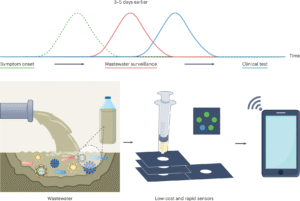🚨 How AI and Wastewater Surveillance Are Changing Virus Detection Forever, UNLV Reveals
In a groundbreaking new study, researchers at UNLV have shown how combining AI with wastewater surveillance could help predict viral outbreaks earlier than ever before — even before the first patient visits a clinic.

AI-powered Disease Detection: A Major Leap for Public Health
Known for its usefulness during the COVID-19 pandemic, wastewater surveillance has become a critical public health tool. It allows scientists to understand how viruses spread, mutate, and impact different communities.
But now, a team at the University of Nevada, Las Vegas (UNLV) has taken this concept several steps further.
What’s New?
A recent study published in Nature Communications introduces an advanced AI algorithm that scours wastewater to identify viral threats faster and more accurately than traditional methods.
The AI-enhanced system developed by UNLV neuroscience graduate student Xiaowei Zhuang can detect new strains of:
-
Influenza
-
Mpox (Monkeypox)
-
Measles
-
Candida auris
-
Gonorrhea
…and other infectious pathogens.
Why This Matters: Early Detection = Stronger Prevention
AI Scans Before Clinical Testing Even Begins
According to Dr. Edwin Oh, a co-author of the study and professor at the Nevada Institute of Personalized Medicine, this technique might be able to detect viruses before the first patient even steps into a clinic.
“Through AI, we can predict how viruses are evolving without testing a single person,” – Dr. Edwin Oh
This is a huge leap from previous methods, which relied heavily on clinical reports and patients showing symptoms. The study found that as few as two to five wastewater samples were enough for the AI to identify unique virus signatures — earlier than conventional detection methods.
How Does This AI Wastewater Algorithm Work?
The AI model can isolate overlapping signals in complex wastewater datasets, helping researchers:
-
Detect new variants early
-
Map viral mutations over time
-
Predict the geographic trajectory of a disease
-
Identify outbreaks without prior knowledge of the virus’s genome
In simpler terms, this tool can find new viral threats even before labs know what they look like genetically — creating a proactive approach to disease surveillance.
Real-World Testing in Southern Nevada
Between 2021 and 2023, the research team tested almost 3,700 wastewater samples from Southern Nevada, collected through collaboration with:
-
Southern Nevada Water Authority (SNWA)
-
Southern Nevada Health District
-
Desert Research Institute
-
Cleveland Clinic Lou Ruvo Center for Brain Health
This AI-powered solution was highly accurate and robust, even in rural or under-resourced areas where clinics and lab testing are limited.
“This new tool strengthens our ability to act quickly and effectively. It’s especially useful in low-resource communities,” – Dr. Duane Moser, Desert Research Institute
Looking Ahead: A Global Tool for Outbreak Management?
Zhuang says this innovative AI method allows healthcare teams to monitor population-level virus evolution in real time, dramatically improving public health decision-making for:
-
Local governments
-
National health agencies
-
Global disease prevention organizations
With continued support, this system could become a global standard in early warning systems for pandemics.
Collaborative Success Driving Innovation
“This is what successful public health innovation looks like — strong science, AI innovation, and multi-agency collaboration,”
– Daniel Gerrity, Principal Research Microbiologist, SNWA.
With over 30 joint research projects across institutions, the AI-based wastewater detection project is now among the first in the world to use this method for real-time virus surveillance.
Final Thoughts: Why This Breakthrough Could Save Lives
In the post-pandemic world, speed in detecting emerging viruses could be the difference between containment and catastrophe. This UNLV-led study proves AI can give our health systems an edge in this race — identifying outbreaks before they become crises.